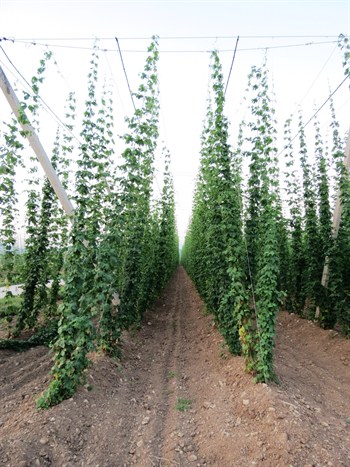A trip report about an amazing plant, beautiful rural countryside and two hops farmers

At the beginning of July I was traveling in Slovenia, the northern ex-Jugoslav republic and a EU country at present. It was my vacation time and I was exploring the beautiful countryside of this magnificent country, when my eyes caught an irregular site: 7 meter poles, with strings connecting a well-organized sky-high network of drip lines and climbing herbaceous plants.
This very impressive layout is not a common site at my country, let alone the other countries of the northern and southern hemisphere that I'm used to support. Needless to say that I immediately turned my rented car towards this weird vineyard. After 5 minutes of some off-road village rally driving (it's a rented car) I arrived to this well maintained orchard. What a view.
My first acquaintance with Hops (Humulus lupulus, Cannabaceae family), was a few years ago, when my Slovenian colleagues asked me for recommendations of foliar feeding of Hops. This was my second eye-to-eye encounter with this 'Jack and the beanstalk' plant. At the orchard I met a farmer and his son, pumping water into the sky-scraper drippers system. "We've never expected a visit at this time of the year by an Israeli agronomist", said the young fella when I introduced myself, "it is quite a refreshing surprise".
After changing handshakes and smiles I started asking about this special growth, and these two gentlemen were keen to share their experience with me. This perennial climber is a temperate climate plant, with an interesting physiology: wakes up at February-March with spring break, vegetative growth and flowering during May-June and bud fill till harvest takes 2-3 more months (late September). Later on it is chopped and goes into dormancy until next year's sprouting, flourishing and blooming again.
The propagation starts from deep rhizomes cuttings that are likely to develop on light-medium fertile, well-drained soils. "What about fertilizers?", I asked these two working chaps. "Well, sometimes we use complex NPK fertilizers, but mainly apply manure and cheap N fertilizers at certain plant phases. We know that the use of specialty fertilizers will give an added value to the crop, but in a year like this one, we just can't afford it".
It takes up around three years to gain proper commercial yield. Till then, the plant develops very little or no yield at all. Being a dioecious, the desired plants are the females, because of the thick rich cones developed from the female flowering buds. When male plants are detected in the field, they must be removed immediately in order to prevent pollination and seeds production: the plant must concentrate on bud filling and thriving rather than wasting precious resources and energy on the seeds. By the way, a typical orchard is cultivated for 15–20 years, sometimes even more.
When buds reach the desired size and weight (in other words – 'nice heavy cones') the whole plant is chopped to the ground, and the complex of plant-strings-heavy cones is taken to a special thresher where it is sliced, diced and the cones are separated.
The expected yield vary between the different varieties, and stands on average of 1.5-2 mt / ha of dry matter buds. In order to preserve the precious yield from quality losses and make the storage and transportation easier, the dry matter is processed into pellets and shipped.
Why the buds?
Well, as these buds contain many flavor and aromatic ingredients such as humulene, xanthohumol, myrcenol, linalool and tannins, you guys might want to know that the lovely bitterness of the beer and the special aroma definitely come from the hops buds. There are other ingredients in charge of the freshness, body and foam stability of the beverage that makes us happy. Just ask the Czechs and the Germans who have a well-respected beer brewing tradition, using hops as a major substance for world leading beer brands. We can agree that the thriving beer industry is quite depended on this plant.
"The situation is not simple at all", said the rigid Slovenian farmer while his son returned to operate the heavy irrigation machinery, just before I left. "There are years when we actually don't earn anything, and we just cover the overhead costs. This year we face very low price for our yield. It's a tricky and high-risk crop, the price fluctuation doesn't really provide a goodnight sleep. We are independent growers – we do not have any contracts with the big breweries", summed up the old man with a bitter smile and invited me to come again next year to observe the fields. "Next year will be better. We believe so, what else can we do?"




